Hugs Day 2025 - when do we celebrate it and what touch brings
Find out the power of one of the most important gestures for the human species.


Learn more about our editorial process
.

Learn more about our editorial process
.

Learn more about our editorial process
.

Learn more about our editorial process
.
Why you can trust us
Articles on Natu.Care are written based on scientific research, data from government websites and other reliable sources. The texts are written in cooperation with doctors, nutritionists and other health and beauty experts. Articles are reviewed before publication and during significant updates.
.Learn more about our editorial process
.Information about advertisements
Content on Natu.Care may contain links to products from the sale of which we may receive a commission. When creating content, we adhere to high editorial standards and take care to be objective about the products discussed. The presence of affiliate links is not dictated by our partners, and we select the products we review ourselves completely independently.
.Learn more about our terms and Conditions
.Hugging has many facets: from a brief welcoming gesture, to cuddling crying babies, to romantic moments with a partner. And each is important.
As an editorial, self-proclaimed cuddling expert, I couldn't deny myself the pleasure of of this text. Snuggle into your partner's side, lean your head against a friend's or parent's shoulder, or call out to your pet and see why touch is so important to humans (and beyond). It's the easiest and (usually) free way to improve your wellbeing.
From this article you will learn:
- When the holiday of hugging falls. .
- How our body reacts to cuddling. .
- What is meant by "quality hugging".
- How does hugging affect the body?
- How cuddling affects social bonds and...your health. .
See also:
- Single on Valentine's Day
- World No Mobile Phone Day
- Sleep hygiene - 8 rules for a good night's sleep
- How to take care of your mental health
- World No Smoking Day
When do we celebrate Hugs Day?
.The dates on which we celebrate Hugs Day are almost as numerous as its benefits. The most well-known worldwide is National Hugs Day, which falls 21 January. Its originator was Kevin Zaborney, who wanted to get Americans to show more affection for each other in this way. The holiday has been celebrated since 1986.
.However, other dates can also be found online: 31 January, when International Hugs Day is supposed to fall, and 24 June, which is recognised as Poland's Hugs Day.
The following are the dates.
Librarians need affection
.Nobody knows why exactly this professional group has earned such a distinction. Nevertheless, 1 March is the International Day of Hugging Librarians. So if you go to the library on this day, don't forget to give the library staff a hug.
Then when do we finally celebrate this Hugs Day? Daily!
.What happens in the body when you hug?
When you fall into someone's arms, on a sensory level you feel the other person's touch and warmth. This information travels via nerve connections from your skin straight to your brain. And this is where the magic begins. Or rather... the chemistry of hormones.
.In simple terms, hormones are chemical compounds produced by the body to 'communicate' between the different systems and organs in the body. Their correct concentrations guarantee both physical health and well-being.
Hugging increases our self-esteem..
 .
.
Jagoda TurowskaPsychologist and social skills trainer
When cuddling there are four main things happening in your body's hormonal economy and:
- .
- the concentration of endorphins increases, .
- oxytocin is secreted, .
- serotonin production increases, .
- cortisol levels decrease, .
What does it do for you?

An analgesic boost of endorphins
.Endorphins are natural analgesic substances produced in the pituitary gland. Their action is based on two mechanisms: on the one hand, they block tachykinins, the main proteins responsible for the transport of pain signals; on the other, they stimulate the production of dopamine, which our central nervous system (CNS) associates with pleasureand.
Yes, in fact, it could be said that we are fooling ourselves a little, by pretending in front of our CNS that it's okay, even when it's not. But in this case it pays off. And it proves, by the way, that the famous excuse of anecdotes: my head hurts... is hardly sensible, as endorphins are also secreted in large quantities during sexand.
Endorphin like morphine
.Did you know that opioid drugs (e.g. morphine) mimic the behaviour of endorphins in their mechanism of action ?
What is oxytocin responsible for?
Oxytocin is the true queen of cuddling and one of the most important social bonding hormones. According to research, it also has an analgesic effect, but it may also improve the body's resistance to stress and thus indirectly support the immune systemand.
This hormone is produced in the hypothalamus and, put simply, makes us feel good and facilitates relaxation. Research also suggests that people with higher levels of oxytocin experience less social anxiety, feel more trust in others and are better at recognising their emotionsand. Oxytocin also helps protect the body from depression and anxiety disordersand.
Unquestionably, as a species, we would not survive without oxytocin, as it is mainly responsible for building relationships and bonds - both with a partner and with other family members and friends . This is why it is often referred to as the hormone of love or friendship.
Physiological oxytocin
.In the body of pregnant women, oxytocin is the hormone that triggers labour action and later lactation. In men, on the other hand, it has an effect on erection and sperm motility.
What does serotonin do?
.Happiness hormone is responsible for mood and well-being. It also supports memory and concentration. It is an essential factor in preventing and treating the development of depression - antidepressants focus their action mainly on stimulating serotonin production and improving its uptake at receptors in the brainand.
Interestingly, in addition to its effects on the psyche, this neurotransmitter also plays important roles in the circulatory system, bowel function, control of urine retention in the bladder and even ejaculation .
.Hormone from... the gut?
.According to scientific studies, only 1-2% of serotonin is produced in the brain. About 90% is produced in the gut thanks to the support of certain strains of probiotic bacteriaand.
This poor cortisol...
.Scary, unwanted, not good. Called the stress hormone. Cortisol in itself is not bad. On the contrary, it increases your chances of survival in crisis situations. It allows you to run faster and longer when you're being chased by a wild boar (a colleague happened to run away...), and if you had to defend yourself when attacked, it will give you more strengthand.
Cortisol increases the release of glucose, which gives the brain an energy kick and the muscles extra powerand. This reaction should be short-lived and cease once the danger has passed. The problem arises when your body starts producing cortisol in excess and for too long.
The reasons for this overproduction are many and could no doubt be the subject for a separate article. So I will limit myself to saying that we undoubtedly live in stressful times, where we are exposed to thousands of stimuli every day. This certainly does not help the nervous system and the hormonal economy.
A simple way to reduce cortisol levels is with a decent cajole. One form of regulating the amount of hormones produced in the body is their antagonistic effect on each other. This means that with the production of hormones associated with relaxation (such as oxytocin and - thanks to endorphins - also dopamine), substances are secreted that block the production of fight-and-flight hormones (such as cortisol)and.
How to get a hug?
.To feel all the benefits of cuddling, however, there are a few things to keep in mind. First and foremost, amateur huggers need to realise that... not everyone is huggable. What to you is an expression of platonic affection, a show of support or even joy at seeing the person, to them may be discomfort.

Each person has an individual approach to personal space. And without his or her consent, it must not be violated. How do you know when someone doesn't feel like diving into your arms? Pay attention to his or her body language. Refrain from physical contact if you see that the person, when attempting to touch you:
- clasps his/her hands on his/her chest, .
- stands sideways towards you, .
- he looks away, starts looking at the ground, .
- strains her muscles, is visibly tense, .
To avoid an awkward situation, it is best if you simply ask if you can hug, especially with people who are not in your immediate circle. Sometimes instead of a hug on a teddy bear a pat on the shoulder or even a handshake will also suffice, but you need the other person's permission for these forms of contact too. Nothing by force.
If we already know we can hug, it is worth opting for longer contact. Experts recommend that a hug should last at least 6-20 seconds. After six seconds, oxytocin starts to be secreted in the brain. And a 20-second hug will help us reduce stress levels and improve cardiovascularand.
Of course, you don't have to hug people with a stopwatch in your hand. Just remember that the longer, the better. If you hug someone, always wait until that person lets you go first. You never know how much that person needs it -that's the best advice I've heard on the subject.
Did you know
.Smoking can increase the risk of premature death by up to 30%! That's like smoking 15 cigarettes a day or being significantly obeseand.
Who can be hugged?
.It is possible to hug absolutely everyone who feels like it. It's not just children and your partner who need touching. Remember to hug other family members too, especially seniors. According to a CBOS survey, they are the loneliest social group in Polandand.
Friends and acquaintances also often don't disdain a good cuddle. And in many situations it can work better than a thousand sentences about how strongly you support them. A hug also demonstrates the bond you have with your loved ones and lets them know that this relationship is important to youand.
If you are a pet carer, remember that they need a dose of daily affection too. OK, it can be hard with fish, but if your pet is a mammal, its hormones work very similarly to those in your body. Hugging your dog or cat reinforces their sense of security and simply brings them joy. And for you, it works similarly to... hugging another humanand.
Natu.Care Collagen Premium 5000 mg, mango & passion fruit
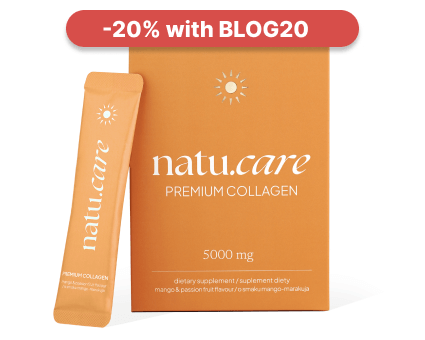
- Collagen content: 5000 mg marine collagen hydrolysate
- Additional active ingredients: vitamin C, low molecular weight hyaluronic acid (and L-theanine and coenzyme Q10 in cocoa flavoured collagen or vitamin A and vitamin E in mango–passion fruit flavoured collagen)
- Form: powder sachets
- Dose: 1 sachet per day
- Sufficient for: 30 days
Product description
Fish collagen from the Natu.Care brand in a dose of 5000 mg, based on certified ingredients of the best quality. Regular supplementation will positively influence the appearance of the skinóry, hairów and nails – they will be rebuilt and strengthened from the inside.
In addition to collagen, which is valuable for health and beauty, it also offers other active ingredients that help to maintain a youthful complexion, shiny hair and strong nails.
The formula contains a sufficient portion of the active ingredient to positively affect joints, the musculoskeletal system and immunity.
Natu.Care Premium Collagen is available in two flavours – Cacao Bloom and Rise&Shine. Both formulas are based on the following active ingredients: marine collagen hydrolysate, wild roseóbud extract and hyaluronic acid.
Additionally, Cacao Bloom contains natural L-theanine, coenzyme Q10 and defatted Dutch cacao. Rise&Shine instead contains vitamin E and vitamin A.
These are the best collagens in the world.
These best fish collagens on the market also rós taste – Cacao Bloom is a treat for chocolate lovers. Rise&Shine will appeal to those whoólike the refreshing taste of mangoófruit and passion fruit.
Pros and cons
Pros:
- Vitamin C supports the body's collagen production, enhancing its effectiveness.
- An effective dose of hyaluronic acid, which additionally supports skin hydration and joint health.
- Fish collagen absorbs 50% better. Additionally, the manufacturer specifies the fish species it is sourced from (Atlantic cod).
- The composition has been tested by the independent and accredited J.S. Hamilton laboratory.
- MSC (Marine Stewardship Council) quality certification, which confirms that the collagen source supports sustainable fishing practices.
Cons:
- None.
Additional information
Natu.Care's fish collagen receives praise for its delicious taste. You won't find the fishy aftertaste that often comes through in other collagens. Plus, you have two tasty flavors to choose from: cocoa and mango-passionfruit.
Active ingredients like coenzyme Q10, hyaluronic acid, and natural L-theanine provide anti-inflammatory and antioxidant benefits while slowing down aging processes.
User review
Super, after about 6 weeks of use, the skin on my face became noticeably firmer. Wonderful taste.
Ania ZalewskaNatu.Care customer
Natu.Care Premium collagen 10 000 mg, mango-maracuja
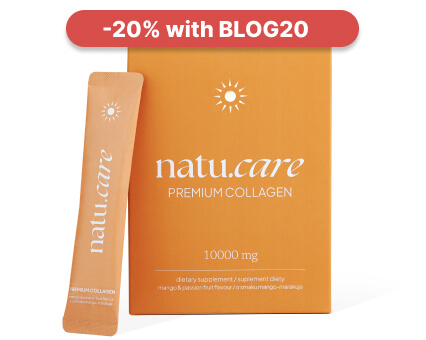
- Collagen content: 10,000 mg marine collagen hydrolysate
- Additional active ingredients: vitamin C, low molecular weight hyaluronic acid (and L-theanine and coenzyme Q10 in cocoa flavoured collagen or vitamin A and vitamin E in mango–passion fruit flavoured collagen)
- Form: powder sachets
- Dose: 1 sachet per day
- Sufficient for: 30 days
Product description
One of the strongest collagens on the market, whichós provides as much as 10,000 mg in a daily serving. This allows the formula to effectively support the condition of the skin, hair and nails.
With this supplement, you will support your beauty, which will allow you to visually stop the ageing process and feel a second youth!
Natu.Care Collagen Premium 10 000 mg comes in two flavours – cherry and mango-maracuja. Both formulas have the same product backbone – collagen, hyaluronic acid and vitamin C.
In the cherry version you additionally find glucosamine, chondroitin and Indian frankincense resin extract. Mango-maracuja, on the other hand, contains vitamin E and vitamin A.
Pros and cons
Pros:
- Tested collagen formula – SeaGarden, whose effects have been confirmed in clinical studies.
- Effective dose of hyaluronic acid, additionally moisturizing the skin and positively impacting joint health.
- Vitamin C supports the body’s natural collagen production.
- The composition has been tested by the independent and accredited J.S. Hamilton laboratory.
- The product has an MSC (Marine Stewardship Council) quality certification – the collagen source supports sustainable fishing practices.
Cons:
- None.
Additional information
Users praise Natu.Care Collagen Premium for the easy dissolvability of the powder.
User review
I noticed a significant improvement in my skin texture after a few weeks of taking collagen regularly. My complexion is now as soft as velvet!
Natu.Care Collagen Premium 10000 mg, cherry
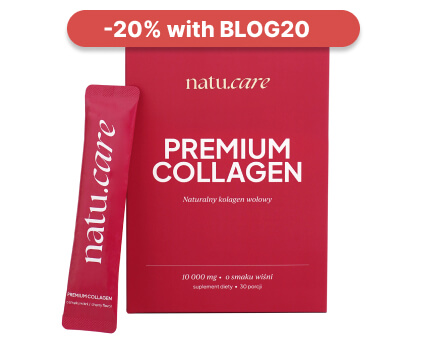
- Collagen content: 10,000 mg of hydrolyzed bovine collagen
- Additional active ingredients: vitamin C, low molecular weight hyaluronic acid, glucosamine, chondroitin, extract of Indian frankincense resin (boswellia serrata)
- Form: powder sachets for drinking
- Serving: 1 sachet per day
- Lasts for: 30 days
Product description
One of the strongest collagens on the market, providing as much as 10,000 mg per daily serving. This product can effectively support the condition of joints, skin, hair, and nails.
With this supplement, you will support your skeletal and joint system as well as your beauty, helping you visually halt the aging process and feel rejuvenated!
Pros and cons
Pros:
- The daily portion of collagen is very large – as much as 10,000 mg.
- Proven collagen formula – COLLinstant, whose effectiveness has been confirmed in clinical studies.
- Effective dose of hyaluronic acid, which additionally moisturizes the skin and positively affects joint health.
- Vitamin C supports the body's natural collagen production.
- Glucosamine is a fundamental building block of compounds found in joint cartilage and a component of collagen that gives elasticity to connective tissue in tendons.
- Chondroitin is a natural component found in the human body, mainly in cartilage. This large molecule (mucopolysaccharide) has the ability to absorb water, which helps maintain the elasticity and resilience of cartilage.
- Frankincense resin extract supports blood circulation and joint mobility and reduces their stiffness. It may help alleviate inflammatory conditions.
- The composition has been tested by the independent and accredited J.S. Hamilton laboratory.
Cons:
- None.
Additional information
Users praise Natu.Care Collagen Premium for the easy dissolving of the powder.
Premium Sodium Butyrate
Product description
Premium Sodium Butyrate is a natural support for your digestive system. With a high dose of butyric acid (940 mg), it supports the regeneration of the intestinal mucosa, improving gut health and function, and aids in the absorption of nutrients. By taking care of your intestines, you're taking care of the health of your entire body.
Studies involving people suffering from irritable bowel syndrome confirm that sodium butyrate is ideal for supporting issues related to bacterial flora imbalances (for example, after antibiotic therapy), constipation and diarrhea, inflammation of the intestinal mucosa, or a diet low in fiber.
Premium Sodium Butyrate capsules are made using the innovative DRcaps® technology. This guarantees that the active ingredients in the product are protected from the destructive effects of stomach acids and digestive enzymes. As a result, we can be sure that the beneficial ingredients are released in the small intestine and are fully absorbed by our body.
Premium Sodium Butyrate from Natu Care is 100% tested, and its composition contains only the highest quality raw materials.
Pros and cons
Pros:
- Supports digestive system function
- Helpful for various gastrointestinal conditions, including IBS
- High dose of butyric acid in each capsule
- Eco-friendly, clean, and tested composition
- Free from added sugar, gluten, GMOs, and lactose
- Innovative capsule technology - DRcaps
Cons:
- None
Additional Information
Take 3 capsules daily at any time of the day, preferably with a meal. Swallow the capsules whole with water.
Premium Sodium Butyrate is intended for adults.
The product should be used under medical supervision.
User review
I've been using the product for 2 weeks. My stomach feels lighter, and my digestion has improved. I recommend it.
Natu.Care Premium Magnesium + Vitamin B6
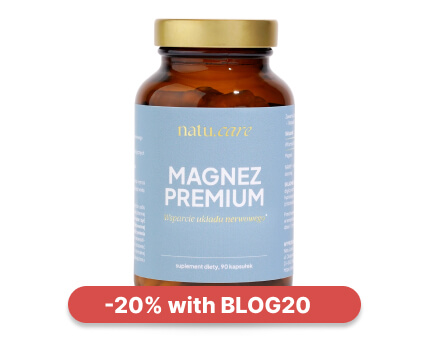
- Magnesium content per day: 305 mg
- Additional active ingredients: Vitamin B6 (2.1 mg)
- Form: capsules
- Serving size: 3 capsules per day
- Sufficient for: 30 days
Product description
The Premium Magnesium + Vitamin B6 dietary supplement is a comprehensive product that combines three organic forms of magnesium (citrate, malate, and diglycinate) and vitamin B6 in highly absorbable forms.
Magnesium is an essential mineral without which our bodies cannot function properly. It supports the immune, nervous, and muscular systems, maintains electrolyte balance, and is involved in cell division and the regulation of mental functions.
Research shows that magnesium supplementation is even more effective when accompanied by vitamin B6, which is included in our product. Vitamin B6 is responsible for the proper functioning of the nervous and immune systems, as well as the proper functioning of the heart.
If you want to safely get rid of feelings of fatigue, concentration problems, hair loss, muscle cramps, trembling, or irritability, reach for Premium Magnesium from Natu.Care, tested by the independent, certified laboratory J.S. Hamilton Poland.
Pros and cons
Pros
- Supports the proper functioning of the nervous and immune systems.
- Reduces feelings of fatigue and tiredness.
- Maintains proper psychological functions.
- The purity of the ingredients (free from anti-caking agents, artificial fillers, and additives such as titanium dioxide, microcrystalline cellulose, talc, magnesium stearate, and silicon dioxide) has been confirmed by laboratory tests.
- High absorption of ingredients.
- Soft capsules that are easy to swallow.
- Suitable for vegetarians and vegans.
Cons
- None.
Additional information
Take with a meal, 3 capsules per day.
The capsules should be taken with at least 250 ml of water.
If you have trouble sleeping, it is advisable to take 1 capsule in the morning and 2 capsules in the evening, no later than 4 hours before bedtime.
Avoid combining with products high in calcium (milk, yogurt, cheese), as this may negatively affect magnesium absorption.
Pregnant and breastfeeding women should consult a doctor before starting supplementation.
User review
I’m very impressed with the speed of delivery. The product itself is of high quality and absorbs well. After two weeks of supplementation, I’ve noticed a significant improvement in muscle recovery, especially during periods of intense training. I highly recommend it!
Product description
The dietary supplement contains omega-3ᵀᴳ, or omega-3 acids in the form of trójglyceridesów. Scientific studies suggest that this form of fatty acidsós up to 2 times better absorbed than the estersós present in many dietary supplements on the market. This means that you are assured of their effectiveness and of supplying yourself with valuable omega acids.
Fatty acids omega-3 are derived from wild anchovy oil. It is a rich source of healthy fats that are essential for the health of the cardiovascular, immune and nervous systems, as well as the proper function of vision, joints muscles.
Scientific research suggests that wild anchovies are a good source of healthy fats.
Scientific research also suggests that an adequate intake of omega-3 fatty acidsós protects against and supports the treatment of depression and anxiety disorders. In addition, omega-3s influence the hydration and appearance of the skinóry and support healthy sleep.
.
The formula contains a total of 750 mg of EPA+DHA acidsós, which is three times higher than the recommended minimum of 250 mg for the Polish population. Omega-3 TG Premium has studies indicating that its TOTOX is 9, which is a very good result.
Supplementation of omega-3 fatty acidsóis recommended for anyone who does not eat 1–2 portions (approximately 300 g) of oily fish per week. Children during growth, seniors, physically active people, vegans and vegetarians, as well as patients undergoing cardiovascular treatment and prevention of heart disease also have an increased need.
Pros and cons
The dietary supplement contains omega-3ᵀᴳ, or omega-3 acids in the form of trójglyceridesów. Scientific studies suggest that this form of fatty acidsós up to 2 times better absorbed than the estersós present in many dietary supplements on the market. This means that you are assured of their effectiveness and of supplying yourself with valuable omega acids.
Fatty acids omega-3 are derived from wild anchovy oil. It is a rich source of healthy fats that are essential for the health of the cardiovascular, immune and nervous systems, as well as the proper function of vision, joints muscles.
Scientific research suggests that wild anchovies are a good source of healthy fats.
Scientific research also suggests that an adequate intake of omega-3 fatty acidsós protects against and supports the treatment of depression and anxiety disorders. In addition, omega-3s influence the hydration and appearance of the skinóry and support healthy sleep.
.
The formula contains a total of 750 mg of EPA+DHA acidsós, which is three times higher than the recommended minimum of 250 mg for the Polish population. Omega-3 TG Premium has studies indicating that its TOTOX is 9, which is a very good result.
Supplementation of omega-3 fatty acidsóis recommended for anyone who does not eat 1–2 portions (approximately 300 g) of oily fish per week. Children during growth, seniors, physically active people, vegans and vegetarians, as well as patients undergoing cardiovascular treatment and prevention of heart disease also have an increased need.
Additional information
The dietary supplement contains omega-3ᵀᴳ, or omega-3 acids in the form of trójglyceridesów. Scientific studies suggest that this form of fatty acidsós up to 2 times better absorbed than the estersós present in many dietary supplements on the market. This means that you are assured of their effectiveness and of supplying yourself with valuable omega acids.
Fatty acids omega-3 are derived from wild anchovy oil. It is a rich source of healthy fats that are essential for the health of the cardiovascular, immune and nervous systems, as well as the proper function of vision, joints muscles.
Scientific research suggests that wild anchovies are a good source of healthy fats.
Scientific research also suggests that an adequate intake of omega-3 fatty acidsós protects against and supports the treatment of depression and anxiety disorders. In addition, omega-3s influence the hydration and appearance of the skinóry and support healthy sleep.
.
The formula contains a total of 750 mg of EPA+DHA acidsós, which is three times higher than the recommended minimum of 250 mg for the Polish population. Omega-3 TG Premium has studies indicating that its TOTOX is 9, which is a very good result.
Supplementation of omega-3 fatty acidsóis recommended for anyone who does not eat 1–2 portions (approximately 300 g) of oily fish per week. Children during growth, seniors, physically active people, vegans and vegetarians, as well as patients undergoing cardiovascular treatment and prevention of heart disease also have an increased need.
Expert opinion
The dietary supplement contains omega-3ᵀᴳ, or omega-3 acids in the form of trójglyceridesów. Scientific studies suggest that this form of fatty acidsós up to 2 times better absorbed than the estersós present in many dietary supplements on the market. This means that you are assured of their effectiveness and of supplying yourself with valuable omega acids.
Fatty acids omega-3 are derived from wild anchovy oil. It is a rich source of healthy fats that are essential for the health of the cardiovascular, immune and nervous systems, as well as the proper function of vision, joints muscles.
Scientific research suggests that wild anchovies are a good source of healthy fats.
Scientific research also suggests that an adequate intake of omega-3 fatty acidsós protects against and supports the treatment of depression and anxiety disorders. In addition, omega-3s influence the hydration and appearance of the skinóry and support healthy sleep.
.
The formula contains a total of 750 mg of EPA+DHA acidsós, which is three times higher than the recommended minimum of 250 mg for the Polish population. Omega-3 TG Premium has studies indicating that its TOTOX is 9, which is a very good result.
Supplementation of omega-3 fatty acidsóis recommended for anyone who does not eat 1–2 portions (approximately 300 g) of oily fish per week. Children during growth, seniors, physically active people, vegans and vegetarians, as well as patients undergoing cardiovascular treatment and prevention of heart disease also have an increased need.
Natu.Care Vitamin D 2000 UI
Product description
Vitamin D plays a crucial role in our health and well-being. It affects calcium and phosphate metabolism, which translates to healthy bones and teeth. It also helps regulate the immune system, and studies indicate its influence on the functioning of the nervous system.
Vitamin D, although called a “vitamin,” is actually a prohormone that our body produces on its own, primarily under the influence of sunlight. Unfortunately, our modern lifestyle contributes to deficiencies of this essential vitamin. Working in enclosed office buildings, using (necessary!) SPF creams, and covering the body with clothing all make it very difficult, if not impossible, to obtain adequate levels of vitamin D from sunlight. This is why appropriate, year-round supplementation is so crucial.
Vitamin D from Natu.Care is a well-tested vitamin D3 suspended in safflower oil, a plant known for its numerous health benefits. The convenient, easy-to-swallow capsule will make supplementation a part of your daily, healthy routine, improving your overall well-being.
Pros and cons
Pros:
- Ensures proper functioning of the immune system
- Supports the maintenance of healthy bones and teeth
- Maintains proper heart, kidney, and muscle function
- Tested by an independent, certified laboratory
- Convenient and easy-to-swallow capsule
- Clean composition - free from added sugar, gluten, GMOs, lactose, and without preservatives or colorants
Cons:
- None.
Additional Information
Pregnant women and breastfeeding mothers should consult a doctor before using the product. This dietary supplement is intended for a healthy adult population up to the age of 75.
Collagen Booster - Glow Stories
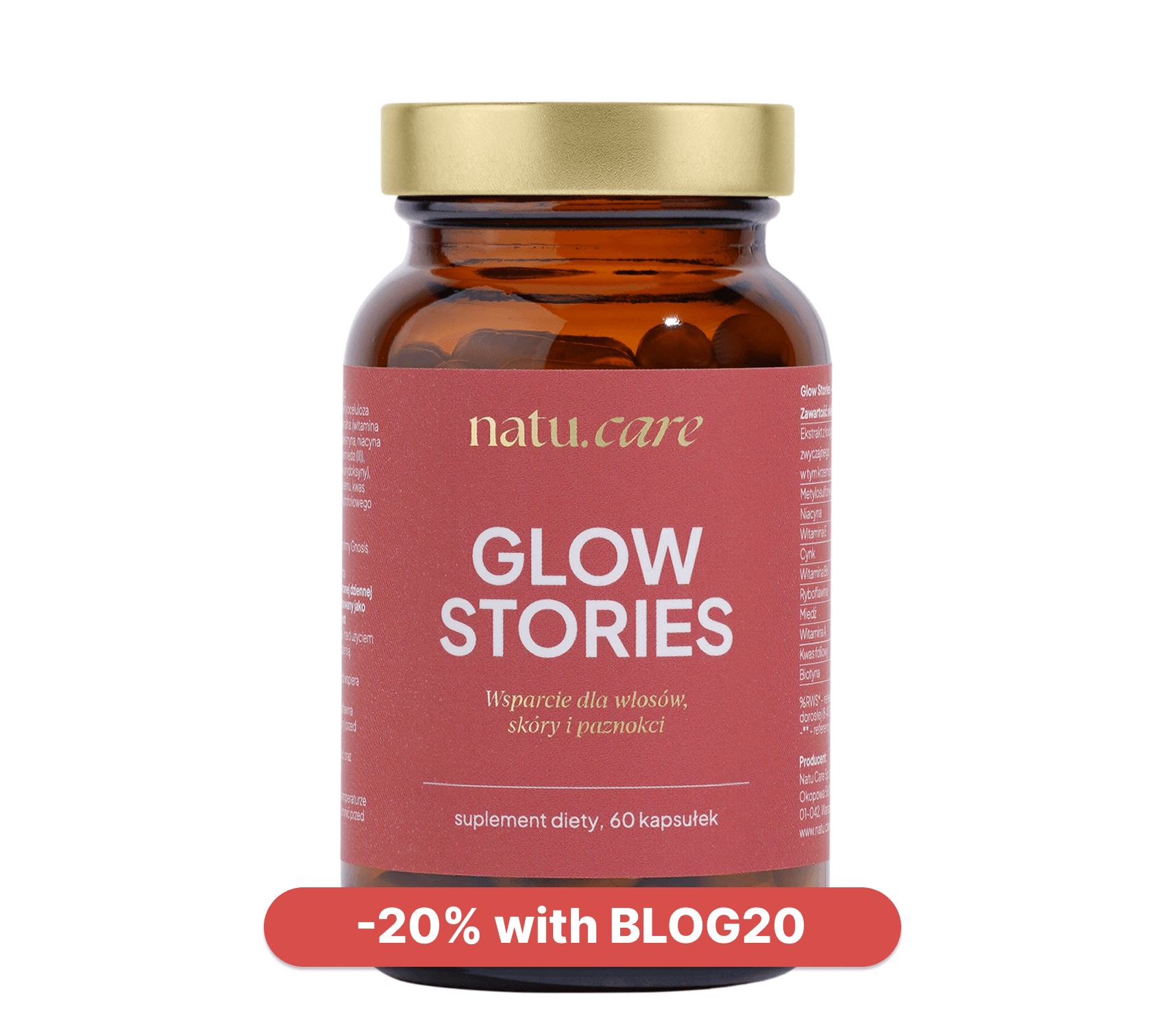
- Active ingredients: bamboo shoot extract, Quatrefolic®, L-Methionine, L-cysteine, vitamin E, vitamin A, niacin (vitamin B3), vitamin B6, vitamin B2 (riboflavin), biotin, zinc, copper
- .
- Form: capsules
- .
- Dose: 1 capsule per day
- .
- Sufficient for: 60 days
- .
Product description
A dietary supplement containing vitamins, minerals and plant extracts thatósupport the skinóhand, hair and nails. The product is especially distinguished by the form of folate – it is Quatrefolic, whichós absorbed very well and is natural.
In addition to valuable vitamins and minerals, such as vitamin A, E, B3, B2 and biotin, the formula contains bamboo shoot extract, whichóry further enhances your beauty.
Pros and cons
A dietary supplement containing vitamins, minerals and plant extracts thatósupport the skinóhand, hair and nails. The product is especially distinguished by the form of folate – it is Quatrefolic, whichós absorbed very well and is natural.
In addition to valuable vitamins and minerals, such as vitamin A, E, B3, B2 and biotin, the formula contains bamboo shoot extract, whichóry further enhances your beauty.
Additional information
A dietary supplement containing vitamins, minerals and plant extracts thatósupport the skinóhand, hair and nails. The product is especially distinguished by the form of folate – it is Quatrefolic, whichós absorbed very well and is natural.
In addition to valuable vitamins and minerals, such as vitamin A, E, B3, B2 and biotin, the formula contains bamboo shoot extract, whichóry further enhances your beauty.
The social aspect of hugging
.Touch has been the basis for building social bonds and has accompanied humanity for much longer than words. This is why gestures are sometimes more powerful than verbal messages. Our body understands them already at a subconscious leveland.
A hug can have many meaningsand:
.- .
- Assert good intentions -e.g. when greeting someone, when you show the person you are greeting that you are kind towards them.
- Show support and comfort - when you want to support someone through difficult emotions they are experiencing.
- Build a sense of security -e.g. by hugging a child in a stressful situation (during a doctor's appointment).
- Cement relationships - when you hug your partner or friend during a movie together and thereby reaffirm to the other party the stability of your relationship or friendship.
- Show joy - when you throw yourself at your mate after a goal by your favourite team or hug a friend after a tough exam she managed to pass.
- Express gratitude - when you hug someone who has given you a gift.
- To be a symbol -for example, when a hug occurs between politicians of two different countries or parties.
- Reflect ideologies - a good example would be tree-hugging activists.
As you can see, innocent hugs are a powerful tool to help any person navigate the confusing world of social relationships, and the meaning of this activity is often given by situational contextand.
Hugging and child development
.Parental touch is also very important for children's development. This is well illustrated by an interesting but cruel experiment conducted in the 1960s by Harry Harlow. He assigned young monkeys (taken from their mothers) to two groups. In one group, the substitute for the nursing mother was a mock-up made of wire, in the other a soft puppet draped in cloth.
During the test, the monkeys were first fed through both mock-ups, and then the animals were fed sometimes through one, sometimes through the other dummy. It turned out that even when the food was fed only through the wire mock-up, the young monkeys spent more time with the mother puppet to which they could cuddle.
The experiment was conducted on the basis of a number of factors.
The experiment showed that the need for touch in young primates appeared to be stronger, or at least as strong, as that associated with hunger satisfactionand.
Touch in very young children is an important part sensory stimulation that influences their development. It has been noted, for example, that orphaned infants from Eastern European regions had impaired growth as well as cognitive development. These children were also more likely to develop serious infections, and later had difficulty building relationshipsand.
A review of research from 2022 indicates that touch in infancy is related to child brain development. It affects the plasticity of neural connections and communication between the brain hemispheres. A lack of touch can therefore result in delayed development, poorer learning abilities, and behaviouraland.
Children who do not experience touch may exhibit more aggressive behaviour and have difficulty relating to peers and other members of their communities.
Hug Day on... Messenger?
.In 2020, in response to pandemic bans on contacting others to enable its users to show support, Facebook has introduced a new emoticon called 'Care' (translated as 'Hold on' in Polish) on its social media and messaging platform. It is the familiar yellow smiley face, holding a heart in its arms.
While such virtual expressions of support are of course nice and certainly worth using towards people we do not have the opportunity to see often, it is important to remember that they are no substitute for physical contact. And if you really want to support someone you can't see, it is much more effective to write them a few words or talk to them on the phone.
The therapeutic power of touch
.Touch therapy, despite appearances, has been around for millennia. One of its forms can include, for example, massage. Recently, however, forms of therapy that are more akin to hugging and other types of tender touch have been gaining popularity.
Touch therapy is a form of therapy that is more akin to hugging and other types of tender touch.
Although traditionally understood 'touch therapy' has at its core a bioenergetic premise and is considered more of a branch of alternative medicine, research indicates that it worksand.
.It should be emphasised here, however, that its positive effects are probably not correlated with the patients' bioenergetic field, but rather the mechanisms related to hormone secretion that I wrote about above. I also mention from the outset that most of the studies confirming the effects of this alternative therapy are of fairly low qualityand.
However, according to a review of scientific papers on 'touch therapy', it canand:
.- reduce pain, .
- alleviate anxiety symptoms, .
- reduce the period of postnatal hospitalisation of preterm infants, .
- improve sleep quality, .
- reduce symptoms of depression, .
At the other extreme lies a 2022 study for which a MATT device was developed for mechanical affective touch therapy ( Mechanical Affective Touch Therapy). It was intended to stimulate touch fibres through gentle vibration. The study involved 22 participants with anxiety disorders.
The subjects were to use the device at least twice a day for four weeks. Outcomes were determined by EEG measurements of heart rate and self-reported mood questionnaires. They suggest that tactile stimulation effectively reduced symptoms of anxiety disorders and increased the ability to concentrateand.
One form of touch therapy can also be considered Sensate Focus, which is a therapeutic technique aimed at romantic partners and is part of sex therapy methods. It involves sensitising partners to touch and deepening the intimacy between themand.
Touching for money...?
.The market for professional huggers around the world emerged in the early 2000s. In Europe, it started to become popular in 2015, while it arrived in Poland fairly recently. The first professional cuddling salon was opened in Warsaw, but now you can also find such a place in Katowice.
.What does it consist of? The service includes a session of professional cuddling without any erotic overtones. During the session you can, for example, lie in the arms of the hugger, hold your head in his lap or sit leaning against his shoulder or chest.
Some hugging salons have their own hugging parlours.
Some cuddle parlours additionally offer the option of watching a movie, preparing a meal together or even taking a walk.
.If this reminds you of a substitute for being in a relationship, then... you're right. That's what paid cuddling is all about. In an age when social contact has moved to the virtual world and social loneliness is on the rise, the market has aired its opportunity.
It's not a bad thing.
Is this a bad thing? I leave it to your judgement. Certainly, however, the development of such professional forms of cuddling could be an interesting supportive therapy for people who have problems with interpersonal bonding or who are hypersensitive to touch due to past traumas. However, this is a song of the future, as for the time being it is difficult to talk about any real professionalisation of this type of service.
How much does it cost?
.For thirty minutes of professional cuddling, you have to pay between £50 and £80, while an hour costs in the region of £80-150.
Not just feeling good - why cuddling is worth it?
.Scientific research links the salutary power of touch and hugs with the many positive aspects your body can feel thanks to the hormones secreted at the time.
Hugging positively affects health becauseand:
- lowers blood pressure, .
- regulates heart function, .
- helps promote normal intestinal peristalsis, .
- reduces the level of pain experienced, .
- supports immunity, .
A 2021 study of 20,000 Canadian seniors found that those who hugged more often rated their health and well-being as better than those who did not enjoy hugsand.
A 2004 study of 59 premenopausal women, on the other hand, suggests a positive correlation between frequency of hugging with a partner and blood pressure values and slowing of heartbeats .
.Hugs like a vaccine?
.A 2014 study found that people who hug frequently are less likely to contract upper respiratory infections. This is due to the immunomodulatory properties that oxytocinand may exhibit. In short, when you're depressed, you get sick more easily from various diseases. Oxytocin secreted when cuddling prevents this.
Is it even appropriate...?
.A few nice years ago I asked my grandmother if she hugs her grandfather sometimes. She looked at me as if possessed and replied with indignation: "Come on, child... In your old age it's no longer appropriate!". What's more, this attitude doesn't only apply to seniors. Many middle-aged people forget the magical power of touch or focus exclusively on cuddling children.
And when those children finally fly out of the nest, they are left with two people who have already forgotten that it is possible to cuddle each other. I asked psychologist and couples therapist Jagoda Turowska about the reasons for this.
What about the lesser tendency of middle-aged people to cuddle - this is often due to looking at what others will say. That is, it is such a fear of being judged and of someone looking at it strangely..
 .
.
Jagoda TurowskaPsychologist and social skills trainer
"As we get older, personalities also change - many people become more reserved, resulting in less hugging. Additionally, the issue of hugging is also an emotional bond that we often don't care about. With the passage of time and lack of communication about closeness, we distance ourselves from our partner, resulting in a lack of hugging or kissing." - adds expert.
It's worth taking care of emotional connections just as much as you take care of your health - they are an integral part of your wellbeing. And if you're still wondering if it's appropriate, let me put it simply: at any age it's appropriate to hug your loved ones. After all, this warm and affectionate form of touch has so many benefits that doctors could prescribe it.
See also:
- Fish Day
- Clean Air Day
- World Food Day
- Great Bees Day
- Bone Marrow Donor Day
- Day of Blood Donation
- National Kindergarten Day
- Lung health after a pandemic
Summary
.- Hugging is a natural human activity that builds social bonds.
- When cuddling with another person, the hormones endorphins, oxytocin and serotonin are secreted in the body, and the concentration of cortisol decreases.
- When cuddling with another person, the hormones endorphins, oxytocin and serotonin are secreted in the body.
- The hormones produced then provide relaxation, well-being and help build resistance to stress. .
- To feel the soothing power of a hug, a hug should last at least six seconds. .
- When hugging, take care of others' boundaries. Don't do anything by force and always make sure that the person being hugged is willing and consenting.
- Take care.
- Hugging has a range of social meanings: from a gesture of friendly greeting to showing support to expressing symbolism and ideology.
- Hugging a child conditions his/her normal behavioural and cognitive development. It also influences his or her immune system and physical growth.
- There are many forms of touch therapy and each has a positive impact on health and wellbeing. Although this is not always the case based on the accepted assumptions of how they work.
- Hugging has a positive effect on the functioning of many systems in the body. Your cardiovascular system will particularly benefit.
FAQ
.When is Hugs Day 2024?
.National Hugs Day falls on 21 January each year. Other dates when cuddling your loved ones (and more) is particularly encouraged are 31 January and 24 June. However, it is best to celebrate Hugs Day every day.
What does hugging give you?
.Hugging allows you to relax, build a sense of closeness and cope better with stress. By cuddling you can also lower your blood pressure, slow down your heart rate and even improve your bowel function and boost your immunity. Regular cuddling helps to maintain good health and also strengthens relationships with your loved ones. That is why it is worth hugging every day.
Is it possible to fall in love through hugging?
.Hugging serves to strengthen bonds and build affectionate, kindness-based relationships with loved ones. Oxytocin, which is released during this activity, is the primary hormone responsible for feeling attached to others. It is associated with a more lasting and stable feeling - love (but not always the romantic kind). This is because the hug is often of a completely platonic nature.
.In addition to oxytocin, hugging also causes a release of endorphins and serotonin.
.When we fall in love, we are instead accompanied by a cocktail of phenylethylamine, noradrenaline, dopamine and serotonin. It's quite an explosive mix that can often keep us awake at night, making it difficult to concentrate and focus our thoughts on anything other than the object of our sighs.
Hugging has a decidedly more relaxing effect, but is a powerful bonding stimulus with another person. In some situations, it can also have a sexual context. However, if hugging people are not romantically attracted to each other, they are unlikely to ignite passionate feelings for each other from hugging alone.
How to cuddle platonically?
.Platonic hugs know no gender or age barriers. You can hug everyone - if they feel like it. However, it is worth ensuring that the person being hugged has no doubt that the hug is purely platonic.
The safest form of hugging is to give someone a 'bear hug'. In a bear hug your hands should be on the upper half of the hugger's back. And it is better not to cross this boundary, for your mutual comfort. If you want to emphasise more strongly the friendly tone of the hug, you can also pat the other person on the back.
Does a hug mean anything?
.Hugging can have many meanings, depending on the situational context. A hug can be a form of friendly greeting that illustrates that we like and miss the person. It can also be a method of showing support to someone in a difficult situation.
Hugging shows attachment and closeness. It emphasises the bond between you. That's why it's worth hugging not only romantic partners or family members. Also acquaintances, friends and even your pets will be happy to receive this gesture.
Hugging is not just for romantic partners or family members.
Is it okay to cuddle with a psychologist?
.In psychotherapy, hugging is not recommended and professionals are unlikely to use it. This is due, among other reasons, to the fact that therapy sessions should be based on a professional patient-therapist relationship. The boundaries of professional ethics, a sense of security and cultural differences therefore stand against hugging.
However, it should be remembered that no two therapies are identical and much depends on the specific circumstances, the patient's situation and the therapist himself.
How many seconds of cuddling?"
.To reap the initial benefits of hugging, it should last at least six seconds. This is the time after which the secretion of oxytocin - a hormone that helps you relax and feel safe - begins. Much more good will happen when the hug lasts for at least 20 seconds. Then you will discover the full health benefits of hugging.
Instead of counting down the time, simply ensure that you hug as often as possible and stay in that closeness for as long as both parties want.
Resources
.See all
.4 Important New Discoveries About Hugging | Psychology Today. (n.d.). Retrieved January 9, 2024, from https://www.psychologytoday.com/us/blog/the-asymmetric-brain/202202/4-important-new-discoveries-about-hugging
A novel role of oxytocin: Oxytocin-induced well-being in humans. (n.d.). Retrieved January 9, 2024, from https://www.jstage.jst.go.jp/article/biophysico/16/0/16_132/_article
Ardiel, E. L., & Rankin, C. H. (2010). The importance of touch in development. Paediatrics & Child Health, 15(3), 153-156. https://doi.org/10.1093/pch/15.3.153
Bamalan, O. A., Moore, M. J., & Al Khalili, Y. (2023). Physiology, Serotonin. In StatPearls. StatPearls Publishing. http://www.ncbi.nlm.nih.gov/books/NBK545168/
Berger, M., Gray, J. A., & Roth, B. L. (2009). The Expanded Biology of Serotonin. Annual Review of Medicine, 60(1), 355-366. https://doi.org/10.1146/annurev.med.60.042307.110802
Cacioppo, J. T., & Patrick, W. (2008). Loneliness: human nature and the need for social connection (pp. xiv, 317). W W Norton & Co. https://www.researchgate.net/publication/232518458_Loneliness_Human_Nature_and_the_Need_for_Social_Connection
Carpenter, L. L., Kronenberg, E. F., Tirrell, E., Kokdere, F., Beck, Q. M., Temereanca, S., Fukuda, A. M., Garikapati, S., & Hagberg, S. (2022). Mechanical Affective Touch Therapy for Anxiety Disorders: Feasibility, Clinical Outcomes, and Electroencephalography Biomarkers From an Open-Label Trial. Frontiers in Psychiatry, 13. https://www.frontiersin.org/articles/10.3389/fpsyt.2022.877574
Cascio, C. J., Moore, D., & McGlone, F. (2019). Social touch and human development. Developmental Cognitive Neuroscience, 35, 5-11. https://doi.org/10.1016/j.dcn.2018.04.009
Chaudhry, S. R., & Gossman, W. (2023). Biochemistry, Endorphin. In StatPearls. StatPearls Publishing. http://www.ncbi.nlm.nih.gov/books/NBK470306/
.Does Hugging Provide Stress-Buffering Social Support? A Study of Susceptibility to Upper Respiratory Infection and Illness-Sheldon Cohen, Denise Janicki-Deverts, Ronald B. Turner, William J. Doyle, 2015. (n.d.). Retrieved 9 January 2024, from https://journals.sagepub.com/doi/10.1177/0956797614559284
Dreisoerner, A., Junker, N. M., Schlotz, W., Heimrich, J., Bloemeke, S., Ditzen, B., & van Dick, R. (2021). Self-soothing touch and being hugged reduce cortisol responses to stress: A randomized controlled trial on stress, physical touch, and social identity. Comprehensive Psychoneuroendocrinology, 8, 100091. https://doi.org/10.1016/j.cpnec.2021.100091
Forsell, L. M., & Åström, J. A. (2012). Meanings of Hugging: From Greeting Behavior to Touching Implications. Comprehensive Psychology, 1, 02.17.21.CP.1.13. https://doi.org/10.2466/02.17.21.CP.1.13
Garrett, B., & Riou, M. (2021). A rapid evidence assessment of recent therapeutic touch research. Nursing Open, 8(5), 2318-2330. https://doi.org/10.1002/nop2.841
Haynes, A. C., Lywood, A., Crowe, E. M., Fielding, J. L., Rossiter, J. M., & Kent, C. (2022). A calming hug: Design and validation of a tactile aid to ease anxiety. PLOS ONE, 17(3), e0259838. https://doi.org/10.1371/journal.pone.0259838
Jones, C., Barrera, I., Brothers, S., Ring, R., & Wahlestedt, C. (2017). Oxytocin and social functioning. Dialogues in Clinical Neuroscience, 19(2), 193-201. https://doi.org/10.31887/DCNS.2017.19.2/cjones
Kerr, F., Wiechula, R., Feo, R., Schultz, T., & Kitson, A. (2019). Neurophysiology of human touch and eye gaze in therapeutic relationships and healing: A scoping review. JBI Evidence Synthesis, 17(2), 209. https://doi.org/10.11124/JBISRIR-2017-003549
Lee, D. Y., Kim, E., & Choi, M. H. (2015). Technical and clinical aspects of cortisol as a biochemical marker of chronic stress. BMB Reports, 48(4), 209-216. https://doi.org/10.5483/BMBRep.2015.48.4.275
Li, Q., Zhao, W., & Kendrick, K. M. (2022). Affective touch in the context of development, oxytocin signaling, and autism. Frontiers in Psychology, 13. https://www.frontiersin.org/articles/10.3389/fpsyg.2022.967791
Light, K. C., Grewen, K. M., & Amico, J. A. (2005). More frequent partner hugs and higher oxytocin levels are linked to lower blood pressure and heart rate in premenopausal women. Biological Psychology, 69(1), 5-21. https://doi.org/10.1016/j.biopsycho.2004.11.002
Lv, J., & Liu, F. (2017). The Role of Serotonin beyond the Central Nervous System during Embryogenesis. Frontiers in Cellular Neuroscience, 11. https://www.frontiersin.org/articles/10.3389/fncel.2017.00074
Morrison, I. (2016). Keep Calm and Cuddle on: Social Touch as a Stress Buffer. Adaptive Human Behavior and Physiology, 2(4), 344-362. https://doi.org/10.1007/s40750-016-0052-x
Pike, E. (2018). Professional Cuddling: Stigma, Market Business Plan [Thesis]. https://digitalrepository.salemstate.edu/handle/20.500.13013/685
Take a hug for your health. (n.d.). Patient. Retrieved January 9, 2024, from http://pacjent.gov.pl/aktualnosc/przytul-sie-na-zdrowie
Rogers-Jarrell, T., Eswaran, A., & Meisner, B. A. (2021). Extend an Embrace: The Availability of Hugs Is an Associate of Higher Self-Rated Health in Later Life. Research on Aging, 43(5-6), 227-236. https://doi.org/10.1177/0164027520958698
Romney, C. E., Arroyo, A. C., Robles, T. F., & Zawadzki, M. J. (2023). Hugs and Cortisol Awakening Response the Next Day: An Ecological Momentary Assessment Study. International Journal of Environmental Research and Public Health, 20(7), Article 7. https://doi.org/10.3390/ijerph20075340
Rosa, L., Rosa, E., Sarner, L., & Barrett, S. (1998). A Close Look at Therapeutic Touch. JAMA, 279(13), 1005-1010. https://doi.org/10.1001/jama.279.13.1005
Ruani, A. 'Alex'. (2014, December 17). Hugs, The Ultimate Vaccine. The Health Sciences Academy. https://thehealthsciencesacademy.org/health-tips/hugs/
Santos, P. (2023). Decoupling touch from sex: Gender(ed) representations of physical intimacy in the cuddle industry. Frontiers in Sociology, 8. https://www.frontiersin.org/articles/10.3389/fsoc.2023.998037
Sprouse-Blum, A. S., Smith, G., Sugai, D., & Parsa, F. D. (2010). Understanding Endorphins and Their Importance in Pain Management. Hawaii Medical Journal, 69(3), 70-71. https://www.ncbi.nlm.nih.gov/pmc/articles/PMC3104618/
Tabatabaee, A., Tafreshi, M. Z., Rassouli, M., Aledavood, S. A., AlaviMajd, H., & Farahmand, S. K. (2016). Effect of Therapeutic Touch in Patients with Cancer: A Literature Review. Medical Archives, 70(2), 142-147. https://doi.org/10.5455/medarh.2016.70.142-147
Tajik, P., Shahali, S., & Padmehr, R. (2023). Effects of sensate focus technique and position changing on sexual function of women with deep-infiltrating endometriosis after surgery: A clinical trial study. International Journal of Reproductive Biomedicine, 21(6), 509-520. https://doi.org/10.18502/ijrm.v21i6.13638
Thau, L., Gandhi, J., & Sharma, S. (2023). Physiology, Cortisol. In StatPearls. StatPearls Publishing. http://www.ncbi.nlm.nih.gov/books/NBK538239/
.The role of oxytocin in social bonding, stress regulation and mental health: An update on the moderating effects of context and interindividual differences-ScienceDirect. (n.d.). Retrieved January 9, 2024, from https://www.sciencedirect.com/science/article/pii/S0306453013002369?via%3Dihub
Uvnäs-Moberg, K., Handlin, L., & Petersson, M. (2015). Self-soothing behaviors with particular reference to oxytocin release induced by non-noxious sensory stimulation. Frontiers in Psychology, 5. https://www.frontiersin.org/articles/10.3389/fpsyg.2014.01529
Weiner, L. (2022). Sensate focus touch in sexual health and sex therapy: A critical literature review. The Journal of Sexual Medicine, 19(5, Supplement 2), S152. https://doi.org/10.1016/j.jsxm.2022.03.350
What 20 Seconds of Hugging Can Do for You | Psychology Today. (n.d.). Retrieved 9 January 2024, from https://www.psychologytoday.com/us/blog/keep-it-in-mind/202201/what-20-seconds-hugging-can-do-you
Social ties, research communication, CBOS 2017 https://www.cbos.pl/SPISKOM.POL/2017/K_151_17.PDF
Editorials
Meet the team


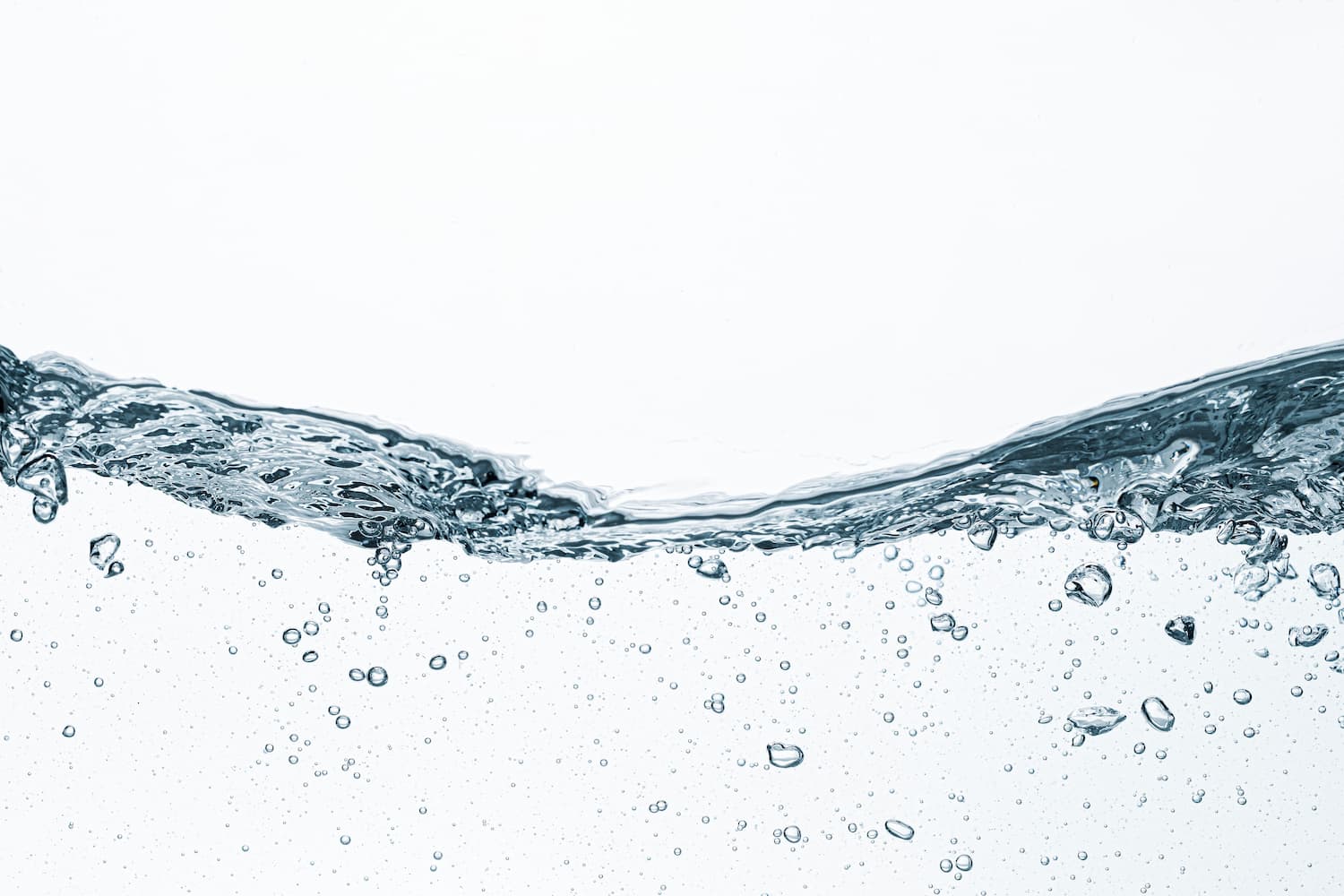
World Water Day aims to raise awareness of the lack of drinking water in many regions of the world.
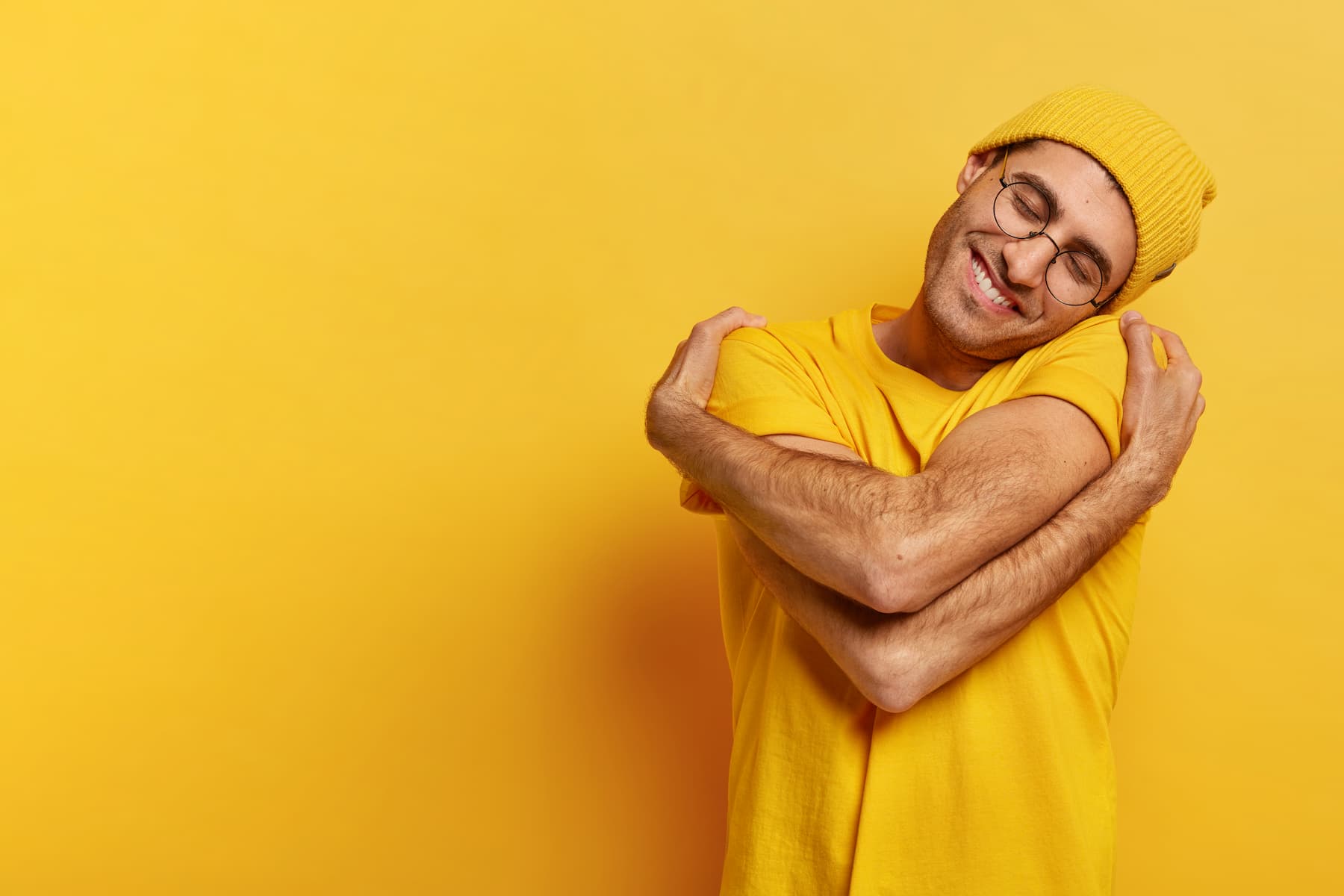
How many Poles are single and why have they chosen to live alone?

World Cancer Day encourages research and healthy lifestyles.



